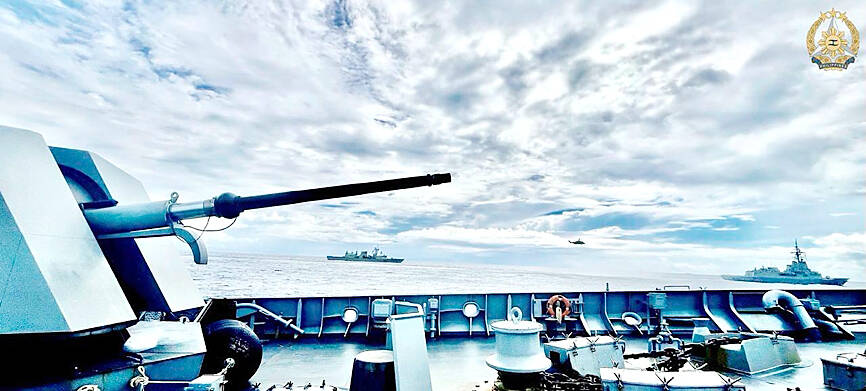This year is already the deadliest since the coup for media operating in Myanmar, with three deaths recorded last month alone as the junta is accused of imposing a “terror campaign” on the press.
Htet Myat Thu, 28, and Win Htut Oo, 26, both freelance journalists, were shot dead during a raid on their home by the military junta on Aug. 21 in the southern Mon state.
In the same week, on Aug. 19, Pe Maung Sein, 50, an award-winning documentary filmmaker, died at a private hospital in Yangon just three days after he had been released from a junta prison.

Photo: AP
Hours of beatings at an interrogation center had left him with five broken ribs and four prolapsed discs, which were untreated for almost two years in jail, where he also endured periods without adequate food.
His wife said he was left paralyzed, and with such severe injuries he was unable to drink, eat or even talk.
In total, four journalists have been killed this year, making it the deadliest for members of the press since the military seized power in February 2021, ousting the government of Aung San Suu Kyi.
The coup was met by widespread opposition from the public, and an armed uprising against the junta.
Journalists documenting the conflict and the frequent human rights abuses by the military, have faced immense dangers.
Hundreds of journalists have also been forced to flee into exile or fled to areas controlled by opposing armed groups, while others work underground.
Pe Maung Sein was arrested in May 2022 while filming in Loikaw, close to the border with Thailand. He wanted to document the conflict and plight of people forced to flee their homes, his wife, Khin Su Naing said.
She said he was kept at an interrogation center where his hands and legs were tied, and he was kicked for hours by a group of soldiers, denied food and allowed only a few sips of water. His memories of what happened next were vague as he lost consciousness. The only thing he remembered was pain.
He was transferred to Loikaw prison, and charged with communicating with blacklisted organizations. He was denied proper medical treatment for his injuries, relying on medicine that his wife sent from Yangon.
When conflict in Loikaw escalated in November last year, Khin Su was unable to communicate with her husband, but learned he had received very little food as the prison had no regular supplies.
He began collapsing from his injuries, and was left paralyzed.
Pe Maung Sein was moved to Loikaw military hospital in April, before being moved again to Yangon, after a request from Khin Su.
Despite being paralyzed, his legs were chained to the hospital bed and he was watched over by armed guards.
Magnetic resonance imaging results showed that he had five broken ribs and four prolapsed discs, while an endoscopic test showed he had a lump in his trachea in addition to bone tuberculosis. He was released four days before his sentence was completed and Khin Su rushed him to a private hospital. He died three days later.
“I had already prepared for him with a wheelchair. I expected him to return home at least as a disabled person, but not like this,” Khin Su said.
Two days after Pe Maung Sein’s death, freelance journalists Htet Myat Thu and Win Htut Oo were shot dead in the country’s south.
On Aug. 21, Thiri Lwin, the girlfriend of Win Htut Oo, received a phone call telling her that gunshots had been heard near the home that her partner shared with Htet Myat Thu in a small town in Southern Myanmar.
Neighbors told her that about 30 military soldiers had raided the house, and both men had been shot.
The military reportedly targeted the house after learning members of a local anti-junta group had visited them. Htet Myat Thu was shot dead as he went outside to open the gates, eyewitnesses said.
Win Htut Oo was killed later.
It was the first time in post-coup Myanmar that a journalist had been shot dead in their home, the advocacy group Reporters Sans Frontieres said.
The deaths in August followed the killing of Myat Thu Tun, also known as Phoe Thiha in January.
He was shot dead while in military custody in Myanmar’s western Rakhine State.
Local media reported that his body, which showed signs of torture, was found buried at a Rakhine State military camp on Feb. 5. He had been arrested in 2022.

Australia has announced an agreement with the tiny Pacific nation Nauru enabling it to send hundreds of immigrants to the barren island. The deal affects more than 220 immigrants in Australia, including some convicted of serious crimes. Australian Minister of Home Affairs Tony Burke signed the memorandum of understanding on a visit to Nauru, the government said in a statement on Friday. “It contains undertakings for the proper treatment and long-term residence of people who have no legal right to stay in Australia, to be received in Nauru,” it said. “Australia will provide funding to underpin this arrangement and support Nauru’s long-term economic

‘NEO-NAZIS’: A minister described the rally as ‘spreading hate’ and ‘dividing our communities,’ adding that it had been organized and promoted by far-right groups Thousands of Australians joined anti-immigration rallies across the country yesterday that the center-left government condemned, saying they sought to spread hate and were linked to neo-Nazis. “March for Australia” rallies against immigration were held in Sydney, and other state capitals and regional centers, according to the group’s Web site. “Mass migration has torn at the bonds that held our communities together,” the Web site said. The group posted on X on Saturday that the rallies aimed to do “what the mainstream politicians never have the courage to do: demand an end to mass immigration.” The group also said it was concerned about culture,

ANGER: Unrest worsened after a taxi driver was killed by a police vehicle on Thursday, as protesters set alight government buildings across the nation Protests worsened overnight across major cities of Indonesia, far beyond the capital, Jakarta, as demonstrators defied Indonesian President Prabowo Subianto’s call for calm. The most serious unrest was seen in the eastern city of Makassar, while protests also unfolded in Bandung, Surabaya, Solo and Yogyakarta. By yesterday morning, crowds had dispersed in Jakarta. Troops patrolled the streets with tactical vehicles and helped civilians clear trash, although smoke was still rising in various protest sites. Three people died and five were injured in Makassar when protesters set fire to the regional parliament building during a plenary session on Friday evening, according to

STILL AFLOAT: Satellite images show that a Chinese ship damaged in a collision earlier this month was under repair on Hainan, but Beijing has not commented on the incident Australia, Canada and the Philippines on Wednesday deployed three warships and aircraft for drills against simulated aerial threats off a disputed South China Sea shoal where Chinese forces have used risky maneuvers to try to drive away Manila’s aircraft and ships. The Philippine military said the naval drills east of Scarborough Shoal (Huangyan Island, 黃岩島) were concluded safely, and it did not mention any encounter with China’s coast guard, navy or suspected militia ships, which have been closely guarding the uninhabited fishing atoll off northwestern Philippines for years. Chinese officials did not immediately issue any comment on the naval drills, but they